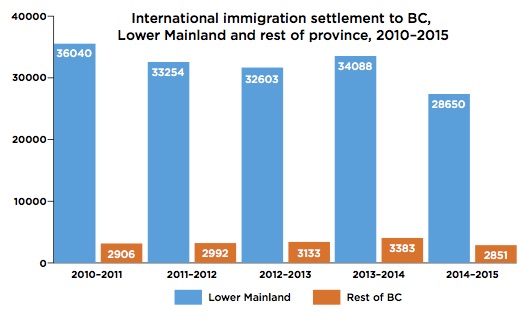A Tale of Two Economies: Leveraging Regional Immigration to Enhance Growth
By Jock Finlayson and Kristine St-Laurent
Two factors will largely determine the future trajectory of economic growth in British Columbia: productivity performance, and the extent to which the labour force expands over time. The hurdles to achieving long-term economic growth include an aging population, a low natural birth rate, and intense global competition for talent and capital.
Urbanization Feeds Divergence
The outlook for economic growth across B.C. is not uniform. In fact, ongoing urbanization and regional gaps in economic opportunity are feeding into a story of two increasingly diverging economies in the province.
Recent immigration flows and settlement patterns show the vast majority of new international migrants choosing to live in the already capacity-stretched Lower Mainland. Most other towns and almost all rural areas in B.C. attract comparatively few newcomers. An inability to expand local labour pools to sustain and spur regional economies creates a risk of long-term stagnation/decline for a significant number of communities across the province.
Immigration Key, Yet Centralized
A recent report estimates that B.C. will have 934,000 job openings between 2015 and 2025, more than two-thirds of which will be “replacement” positions. At the same time, net international migration is expected to add almost 250,000 people to the labour supply to help fill these vacancies. As the natural birth rate declines, all Canadian jurisdictions will increasingly be looking to foreign sources to augment the native-born talent pool.
Indeed, in the not-too-distant future, immigration will be the only source of significant population growth in Canada. In the absence of inflows of economic-class immigrants willing to locate outside of the Lower Mainland, the province may come to be characterized by ever increasing internal disparities.

Source: BC Stats, BC Regional District Migration Components, International Immigrants to BC
Looking back over the last five years, almost all international migrants arriving in British Columbia settled in Metro Vancouver and the Fraser Valley. Only a small number of ended up elsewhere in the province.
Non-Urban Strategies Required
In this circumstance, there is a strong case for developing and deploying regional immigration strategies to attract newcomers and improve the foundation for future growth. Such strategies could market the appeal of the lifestyle afforded by smaller communities, highlighting employment, business and investment opportunities as well as excellent housing affordability relative to the over-priced Metro Vancouver market.
Other steps that might be taken to persuade more new immigrants to consider settling in areas of B.C. beyond the Lower Mainland include the following:
- Government could fast-track immigration for appropriately skilled newcomers and temporary foreign workers willing to locate in non-urban regions for at least five years;
- Communities in a specific geographic area could collaborate to market regional business opportunities and lifestyle advantages to potential immigrant workers, entrepreneurs and investors;
- There may be scope to use homestay programs for international college and university students in more communities, with the option for students to pursue fast-tracked citizenship after graduation;
- For essential job openings where there are demonstrated labour shortages in particular regions, the federal government could exempt employers from having to go through the cumbersome process of obtaining a Labour Market Opinion before hiring foreign workers; and
- The province and local/regional governments could work to leverage current tourism initiatives and B.C.’s burgeoning tourism sector to encourage visitors to consider investing in local businesses.
Benefiting Beyond the Lower Mainland
We believe the B.C. economy would gain if immigration patterns shifted so that future waves of newcomers are less heavily concentrated in the Lower Mainland. This would help to invigorate local communities, bolster the supply of labour in talent-short regions, and ease the pressure on land and housing prices in Metro Vancouver. If even 10 to 15 per cent of the immigrants now streaming into the Vancouver area every year decided to try their hand in other regions, this could be enough to deliver a useful economic jolt to some B.C. communities.
Local community and business organizations must be in the vanguard of efforts to attract and welcome migrants. However, there is also a role for senior levels of government to support this grass-roots work, and also to facilitate the integration of newcomers after their arrival.
The latest academic evidence confirms that immigration is a key factor driving economic growth, innovation and advances in prosperity in all modern economies. It is time to start thinking about how to spread the benefits of immigration across more regions of the province.
Jock Finlayson is executive vice-president and chief policy officer, and Kristine St. Laurent, a policy analyst, with the Business Council of BC.
(PeopleTalk Spring 2017)






